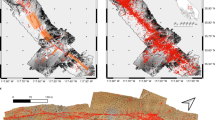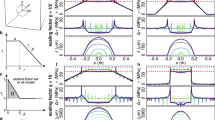Abstract
Fracture energy is a form of latent heat required to create an earthquake rupture surface and is related to parameters governing rupture propagation and processes of slip weakening1,2,3. Fracture energy has been estimated from seismological and experimental rock deformation data4,5,6,7,8, yet its magnitude, mechanisms of rupture surface formation and processes leading to slip weakening are not well defined8,9,10. Here we quantify structural observations of the Punchbowl fault, a large-displacement exhumed fault11,12 in the San Andreas fault system, and show that the energy required to create the fracture surface area in the fault is about 300 times greater than seismological estimates would predict for a single large earthquake. If fracture energy is attributed entirely to the production of fracture surfaces, then all of the fracture surface area in the Punchbowl fault could have been produced by earthquake displacements totalling <1 km. But this would only account for a small fraction of the total energy budget, and therefore additional processes probably contributed to slip weakening during earthquake rupture.
This is a preview of subscription content, access via your institution
Access options
Subscribe to this journal
Receive 51 print issues and online access
$199.00 per year
only $3.90 per issue
Buy this article
- Purchase on Springer Link
- Instant access to full article PDF
Prices may be subject to local taxes which are calculated during checkout




Similar content being viewed by others
References
Ida, Y. Cohesive force across the tip of a longitudinal-shear crack and Griffith's specific surface energy. J. Geophys. Res. 77, 3796–3805 (1972)
Husseini, M. I. & Randall, M. J. Rupture velocity and radiation efficiency. Bull. Seismol. Soc. Am. 66, 1173–1187 (1976)
Andrews, D. J. Rupture dynamics with energy loss outside the slip zone. J. Geophys. Res. 110, B01307 (2005)
Wong, T. F. Shear fracture energy of Westerly granite from post-failure behaviour. J. Geophys. Res. 87, 990–1000 (1982)
Okubo, P. G. & Dieterich, J. H. Effects of physical fault properties on frictional instabilities produced on simulated faults. J. Geophys. Res. 89, 5817–5827 (1984)
Guatteri, M., Spudich, P. & Beroza, G. C. Inferring rate and state friction parameters from a rupture model of the 1995 Hyogo-ken Nanbu (Kobe) Japan earthquake. J. Geophys. Res. 106, 26511–26521 (2001)
Rice, J. R., Sammis, C. G. & Parsons, R. Off-fault secondary failure induced by a dynamic slip-pulse. Bull. Seismol. Soc. Am. 95, 109–134 (2005)
Abercrombie, R. E. & Rice, J. R. Can observations of earthquake scaling constrain slip weakening? Geophys. J. Int. 162, 406 (2005)
Heaton, T. H. Evidence for and implications of self-healing pulses of slip in earthquake rupture. Phys. Earth Planet. Inter. 64, 1–20 (1990)
Kanamori, H. & Heaton, T. H. in GeoComplexity and the Physics of Earthquakes (eds Rundle, J. B., Turcotte, D. L. & Klein, W.) (American Geophysical Union, Washington DC, 2000)
Chester, F. M. & Logan, J. M. Composite planar fabric of gouge from the Punchbowl fault, California. J. Struct. Geol. 9, 621–634 (1987)
Chester, F. M., Chester, J. S., Kirschner, D. L., Schulz, S. E. & Evans, J. P. in Rheology and Deformation in the Lithosphere at Continental Margins (eds Karner, G. D., Taylor, B., Driscoll, N. W. & Kohlstedt, D. L.) (Columbia Univ. Press, New York, 2004)
Kanamori, H. Mechanics of earthquakes. Annu. Rev. Earth Planet. Sci. 22, 207–237 (1994)
Venkataraman, A. & Kanamori, H. Observational constraints on the fracture energy of subduction zone earthquakes. J. Geophys. Res. 109, B05302 (2004)
Beeler, N. M., Wong, T. F. & Hickman, S. H. On the expected relationships among apparent stress, static stress drop, effective shear fracture energy, and efficiency. Bull. Seismol. Soc. Am. 93, 1381–1389 (2003)
Brace, W. F. & Walsh, J. B. Some direct measurements of the surface energy of quartz and orthoclase. Am. Mineral. 47, 1111–1122 (1962)
Friedman, M., Handin, J. & Alani, G. Fracture-surface energy of rocks. Int. J. Rock Mech. Mining Sci. 9, 757–766 (1972)
Wong, T. F. in Earthquake Source Mechanics (eds Das, S., Boatwright, J. & Scholz, C. H.) 1–12 (American Geophysical Union, Washington DC, 1986)
Olgaard, D. L. & Brace, W. F. The microstructure of gouge from a mining-induced seismic shear zone. Int. J. Rock Mech. Mining Sci. 20, 11–19 (1983)
McGarr, A., Spottiswoode, S. M., Gay, N. C. & Ortlepp, W. D. Observations relevant to seismic driving stress, stress drop, and efficiency. J. Geophys. Res. 84, 2251–2261 (1979)
Yund, R. A., Blanpied, M. L., Tullis, T. E. & Weeks, J. D. Amorphous material in high strain experimental fault gouges. J. Geophys. Res. 95, 15589–15602 (1990)
Scholz, C. H., Dawers, N. H., Yu, J. Z., Anders, M. H. & Cowie, P. A. Fault growth and fault scaling laws: Preliminary results. J. Geophys. Res. 98, 21951–21961 (1993)
Andrews, D. J. A fault constitutive relation accounting for thermal pressurization of pore fluid. J. Geophys. Res. 107, ESE15-1–8, art. no. 2363 (2002)
Wilson, J. E., Chester, J. S. & Chester, F. M. Microfracture analysis of fault growth and wear processes, Punchbowl Fault, San Andreas System, California. J. Struct. Geol. 25, 1855–1873 (2003)
Chester, J. S., Kronenberg, A. K., Chester, F. M. & Guillemette, R. N. Characterization of natural slip surfaces relevant to earthquake mechanics. Eos 84(46) (2003)
Wilson, B., Dewers, T., Reches, Z. & Brune, J. Particle size and energetics of gouge from earthquake rupture zones. Nature 434, 749–752 (2005)
Bonnet, E. et al. Scaling of fracture systems in geological media. Rev. Geophys. 39, 347–383 (2001)
Underwood, E. E. Quantitative Stereology (Addison Wesley, Reading, Massachusetts, 1970)
Sibson, R. H. Thickness of the seismic slip zone. Bull. Seismol. Soc. Am. 93, 1169–1178 (2003)
Evans, J. P., Shipton, Z. K., Pachell, M. A., Lim, S. J. & Robeson, K. in Proc. 3rd Conf. on Tectonic Problems of the San Andreas Fault System (eds Bokelmann, G. & Kovach, R. L.) 67–81 (Stanford Univ. Publ., 2000)
Acknowledgements
We thank P. Spudich , T. Heaton and N. Beeler for discussions and review of an early version of this paper, and J. Jenson for advice regarding data analysis. The TEM work was performed in the Microscopy and Imaging Center of Texas A&M University and Z. Luo is acknowledged for his assistance. This research was supported by the Southern California Earthquake Center through a NSF and USGS Cooperative Agreement (J.S.C.), US National Science Foundation (J.S.C. and F.M.C.), and US Geological Survey (J.S.C.).
Author information
Authors and Affiliations
Corresponding author
Ethics declarations
Competing interests
Reprints and permissions information is available at npg.nature.com/reprintsandpermissions. The authors declare no competing financial interests.
Rights and permissions
About this article
Cite this article
Chester, J., Chester, F. & Kronenberg, A. Fracture surface energy of the Punchbowl fault, San Andreas system. Nature 437, 133–136 (2005). https://doi.org/10.1038/nature03942
Received:
Accepted:
Issue Date:
DOI: https://doi.org/10.1038/nature03942
This article is cited by
-
Mechanical model of evolution of granular matter force chains
Granular Matter (2024)
-
Dynamic Pulverization of Rock Under Triaxial Static-Stress and High-Rate Shearing
Rock Mechanics and Rock Engineering (2024)
-
Accrual of widespread rock damage from the 2019 Ridgecrest earthquakes
Nature Geoscience (2022)
-
A Synthesis of Fracture, Friction and Damage Processes in Earthquake Rupture Zones
Pure and Applied Geophysics (2022)
-
Simple shear origin of the cross-faults ruptured in the 2019 Ridgecrest earthquake sequence
Nature Geoscience (2021)
Comments
By submitting a comment you agree to abide by our Terms and Community Guidelines. If you find something abusive or that does not comply with our terms or guidelines please flag it as inappropriate.



